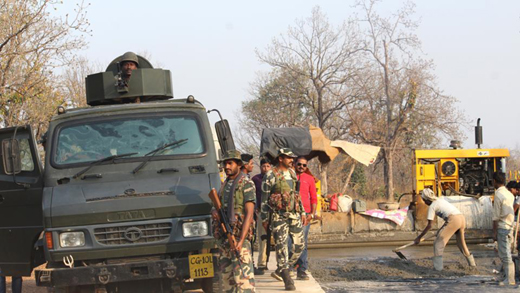Why this jungle highway in Sukma is a graveyard of Indian security forces
Mangalore Today News Network
Chattisgarh, Apr 24, 2017 : A nondescript stretch of road that disappears into a dirt track and a thick canopy of forests in the heart of Chhattisgarh’s red corridor is at the centre of a bruising years-long conflict between the government and Maoist rebels.

The insurgents control the desperately poor region that has seen little government intervention or development in decades, and have struck security forces twice in two months to stop construction.
In March, suspected Maoist rebels ambushed a road-opening party of the Central Reserve Police Force (CRPF) and killed 12.
On Monday, the militants struck again, killing 26 in one of the worst attack on the force in seven years.
The government says the increasing intensity of violence indicates one thing: That the rebels don’t want any road links to pierce their stronghold of Sukma. For the rebels, the roads mean quick access for government troops into their heartland, and cancelling their turf advantage of hostile terrain and guerrilla warfare.
The government knows this and, hence, has an ambitious plan for a pincer grip on the rebels.
The state is building two roads, Injiram-Bheji and Dornapal – Jagargonda, that will connect National Highway 30 and state capital Raipur with the remote, rebel-held areas. Construction of the roads began roughly a decade ago but has progressed at a snail’s pace with contractors unwilling to risk working in a region littered with land mines and booby traps.
Rebels targeted the Injiram-Bheji road in its March 11 attack. On Monday, it focused on stalling the Dornapal – Jagargonda stretch.
The roads are supposed to meet each other deep inside Maoist territory, a nightmare scenario for the rebels who are far outnumbered by government forces. Moreover, it would enable the state administration to bring in schools, hospitals and ancillary development to wean away local villagers from the rebels.
When HT spoke to senior officials after the March 11 attack, most of them appeared certain that the roads would break the back of insurgency in the region.
“Security forces will move with ease in the area after this road is built and this is troubling the Maoists. We are entering their core through this road,” said DM Awasthi, special director general of police (anti-Maoist operations).
The attacks hurt construction work. More than 20 kilometres of the Injiram road is left while just seven of the 56-odd kilometers of the Jagargonda road has been built. But CRPF is defiant.
“Road to poora banega aur hum hi banvayienge… chahe dus nahin, bees shaheed ho jayen (The road will be built and we will build it… even if 20 are martyred),” CRPF assistant sub-inspector Pawan Kumar had told HT in March.
“Maoists are attacking us in frustration. Inka jungle raaj khatam karna hai iss road ko banaake (we have to end their lawless reign by building this road),” said Kumar. Less than a week after the March 11 strike, work on the road resumed.
Courtesy: HT
- Mangaluru: BJP accuses Congress of circulating fake pamphlet
- Over 2.88 crore voters in Karnataka to cast their franchise on April 26
- Communally sensitive DK dist was a narrative created by few: Captain Brijesh Chowta
- BJP protests against Congress government’s ‘anti-people’ policies
- Renowned Yakshagana Bhagavatha Subrahmanya Dhareshwar no more
- People must support Congress to develop DK as land of harmony: Padmaraj
- Railways to operate special trains to clear extra rush during election day
- BJP, Congress candidates end campaign by conducting roadshows in Mangaluru
- There is no Modi wave in DK: Harish Kumar
- Railways to operate election special trains from Bengaluru to Mangaluru, Kundapura
- Cops register case against ABVP activists for holding protest without permission
- Campaigning for 1st phase of Lok Sabha polls in Karnataka ends today
- Credit Card frauds: 5 Ways to protect your hard-earned money from offline & online scams
- RBI plans curbs on suspect bank accounts to fight cyber fraud: Report
- Sunita Kejriwal to lead AAP’s Lok Sabha campaign in Delhi, hold roadshows
- ’Desperation born from fear of defeat’: Siddaramaiah slams Modi, defends 4% Muslim quota
- ED challenges Arvind Kejriwal’s plea in Supreme Court: ’173 phones destroyed’
- 103-year-old CSK fan flaunts love for cricket, wishes to meet MS Dhoni
- How an Indian heart saved a Pakistani teen’s life
- Zomato may soon deliver your order faster if you pay more money
- Poll body to establish over 1800 special polling booths in Karnataka
- Nitish Kumar party leader shot dead in Patna by 4 men on bikes
- BJP Minority Morcha leader criticises PM’s remarks, expelled from party
- Man arrested in connection with murder of Hubbali student sent to 6-day CID custody
- Kotak Mahindra Bank barred by RBI from onboarding new online customers
- New residential complex for the judges inaugurated in Mangaluru
- Absconding accused nabbed after 8 years
- Truck with cylinders turns turtle in Beltangady
- Bhoota Kola artist dies of cardiac arrest
- Development of the country should be our goal: Ganesh Karnik
- Container truck gets stuck under Modankap railway bridge
- Truck crushes bike’s pillion rider near BC Road
- Head constable dies of heart attack
- Udupi: PDO dismissed over financial irregularities
- CREDAI to resume Skill Development Program for Construction Workers in Mangaluru
- John B Monteiro elected president of Rachana Catholic Chamber of Commerce & Industry
- Sudhanshu Rai elected district president of All College Student Association
- Chief Minister to visit Mangaluru, Udupi on August 1
- Nitte University awards PhD degree to Tina Sheetal D’Souza
- Sachitha Nandagopal honoured by CMTAI for Community Service
- CITY INFORMATION
- TRAVEL
- TOURIST INFORMATION
- HEALTH CARE
- MISCELLANEOUS




 Write Comment
Write Comment E-Mail To a Friend
E-Mail To a Friend Facebook
Facebook Twitter
Twitter  Print
Print 

